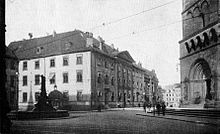Town house (Bremen, 1819–1908)
The Bremer Stadthaus was an authority building of the Free Hanseatic City of Bremen , built from 1818/19 on the foundations of the former archbishop's palatium . In 1909 it had to give way to the extension of the town hall .
With the Reichsdeputationshauptschluss of 1803, the archbishop's palatium, the last administrative seat of the Hanoverian enclave in the city area, fell to the Free Hanseatic City in a very dilapidated condition.
In the years 1818 to 1819, the medieval building was largely demolished and converted into a three-storey administration building in the then modern classicism . The plans came from Nicolaus Blohm , who also managed the construction, but was otherwise more responsible for building the dyke. The east facade without doors at the Palatium now had three entrances. Four pilasters and an attic suggested a central projectile in the wall that was actually straight through . The main entrance led to a spacious hall . From there a three-winged, i.e. H. partly double, partly single-flight stairs to the upper floors.
For nine decades the town hall was the seat of important authorities in the Hanseatic city. At first it also housed two post offices, the city post office and the Prussian post office . In 1818 Bremen had 37,029 inhabitants and the port operations were affected by silting. After the closure of the gate in 1848, the industrialization of Bremen and with it the influx of workers picked up speed. The railway connection (1847) and the Weser Correction (1887–1895) gave the port operations a boost. At the beginning of the 20th century, Bremen's population exceeded 200,000.
The administration's need for office space increased and there was a desire for additional representation and meeting rooms. After a long planning phase, the town house was torn down in 1908/09 and replaced by the New Town Hall . When it was demolished, more medieval building material emerged than expected. Individual parts of the wall had reached the top floor of the previous building.
swell
- Rudolf Stein (1899–1978): Classicism and Romanticism in the Art of Architecture in Bremen, Vol. I, p. 47ff., Verlag HM Hauschild, Bremen 1964 (available in the reading room of the Bremen State Archives )
- Herbert Schwarzwälder : The Great Bremen Lexicon ; 2 volumes, 1016 pages. Edition Temmen, Bremen 2003, ISBN 3-86108-693-X . (available in the reading room of the Bremen State Archives)
- Ernst Ehrhardt (1855–1944): The Palatium of the Bremen Archbishops in the City of Bremen in the Yearbook of the Bremen Collections , 3rd year 1910. (digital collection of the State and University Library Bremen)
Individual evidence
- ↑ Rudolf Stein, Classicism and Romanticism in the Architecture of Bremen , p. 175 ff., The main post office and the Eschenhof





